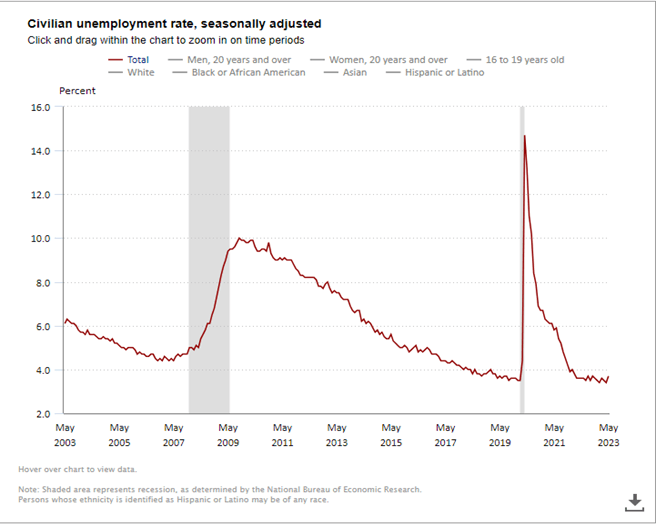The US Economy is Growing but Slowing
The Federal Reserve is at, or very close to, the end of its interest rate hiking cycle after lifting the Fed Fund rate by five percentage points since the end of Q1 2022. According to current market pricing, the US central bank may lift interest rates by 25 basis points in late-July before taking a multi-month pause to see how data and prior monetary tightening play out. US inflation is moving lower but remains uncomfortably high, helped in part by a robust US jobs market, while the economy is growing but at a slower rate.
US headline inflation continues to move lower, driven by a decline in energy prices. In May energy costs fell by 11.7% while food inflation, another notable driver of US price pressures, slowed to 6.7% from a prior month’s 7.7%. The Federal Reserve’s hiking cycle is being felt and the central bank’s hope is that there is still more to come without derailing economic expansion in the coming quarters.
US Inflation Continues to Move Lower

The Q1 growth rate of 1.3% was higher than market expectations but is still half the rate seen in Q4 2022. The multi-week debt ceiling debate, now fully resolved, cast a shadow over economic activity in the US but with fears of a US shutdown now passed, growth could see an uptick moving forward. Fears that tightening lending standards could lead to activity slowing however as companies look at future plans with greater rigor.
US Economy Growing but Slowing

US Fed Funds Probabilities
The current market pricing of Fed Fund probabilities shows the Fed lifting rates by one-quarter -of-one-percentage point in late-July before the central bank hits the pause button again as economic data flows through. While useful, these probabilities change all the time, especially in the run-up to major US economic data releases or events. The one constant over the last few months has been the pricing-in of a series of rate cuts through next year with a lowering of rates by 150 basis points the currently agreed norm. Better-than-expected data may push this cutting cycle forward but the Fed at the moment is openly saying that there will be no cuts this year.
US Fed Fund Rate Probabilities

Source: CME Group, Prepared by Nick Cawley
This mixed backdrop of slower growth and weakening inflation is joined by a steadfastly robust US jobs market where unemployment remains near multi-decade lows while average wages continue to rise. This robust labor market is hampering the Fed’s drive to bring inflation lower, and unemployment will need to rise if the Fed is to keep rates at, or very close to, current levels.

US Dollar Fundamental Outlook
Looking ahead to Q3, the US dollar is likely to remain rangebound with data releases dominating. As discussed, interest rates are close to, or have, bottomed out, while the US debt ceiling debacle, and its effect on short-term US interest rates, is now in the rear-view mirror. The potential for other G7 countries to close their interest-rate differential with the US – the ECB and UK are fully expected to keep hiking rates – will keep downward pressure on the US dollar, or at least temper any move higher. The current ‘wave pattern’ seen in the US dollar index is likely to continue alongside low levels of volatility. The US dollar is set to be driven by external influences as much as domestic data in Q3.

